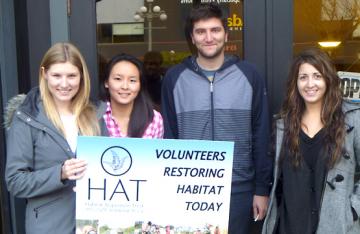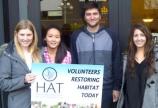Students help local organizations improve energy efficiency
Peter B. Gustavson School of Business
- Jessie Abraham

Last term, I was a member of one of six teams including UVic students who participated in the CRD’s Ready, Set, Solve Challenge. The Challenge paired students from local post-secondary institutions with local organizations to help solve small—but real—energy efficiency and climate-related challenges.
Our team consisted of Inka Foster (third-year psychology), Vicki Tang (2011 BComm graduate), and myself, Jessie Abraham (fourth-year geography). Inka’s strengths derived from her roles as program assistant at Literacy Victoria, green and healthy initiatives coordinator at the Ministry of Health, and Psychology Co-op rep for 2011/12. Vicki provided insight into business, economics and financing from her academic and work experience in entrepreneurship. I brought my background in my studies in Sustainable Urban Development, involvement in the World Student Environmental Summit, and relevant work experience in the green building industry and environmental development.
In September, the organizers, local sponsors and eight student teams from Camosun College, UVic and Royal Roads University came together for a one-day workshop to receive their assigned challenge. Our Challenge was to help Habitat Acquisition Trust (HAT) reduce the energy they use and the emissions they create in their office and through their operations. Here, we also met Peter Papagiannis,our sponsor and liaison from HAT.
Shortly after the initial workshop, where we mapped out our plan and approach, we met with the staff at the HAT office so everyone could be actively involved in the project. They provided us with data on energy use, water use, and waste produced in an average week and with general monthly costs for our review. We analyzed these data and reported on strategies and products that would help. Our report was in the form of a table that included cost, waste, energy, and water savings from implementing each approach and associated BC Hydro incentives.
Understanding the financial constraints of a non-profit organization, we created an informative letter to use in finding donors, as the HAT office could not contribute financially to the project. We provided the necessary information on how to transform their office into an environmentally friendly space in the form of a map that they could mount on their wall to remind them of their goal. And with a few small donations, we purchased CFL light bulbs, small office plants, green cleaning products and environmentally friendly office supplies to help HAT get started.
From our research we also produced a toolkit for Greening Your Office geared towards all businesses in the Capital Regional District, complete with a Guide to Green Office Strategies, a short informative video and a Certified Green Office certificate—to be issued after implementing the strategies outlined in our guide.
Our feedback from HAT was encouraging and constructive: “We are so thrilled that our group of students are going to help us reach our goals of cutting carbon emissions and lowering our energy bills,” says Papagiannis.
For our part, this was an excellent opportunity for us to apply our knowledge and skill sets to local challenges and, ultimately, solve environmental issues beneficial to our community.
Other UVic students participating on teams were:
- Tye Shutty and Nick Ison, who worked with CRD Planning & Protective Services to produce a thorough analysis of multi-modal transportation hubs in the capital region with GIS map outputs that will be used by land use and transportation planners
- Kimberly Veness, Kelsey Lang and Kieran Sroba who worked to develop and test a framework to determine utilization rates of on-street bike racks in downtown Victoria on behalf of the City of Victoria and developed and implemented a survey for cyclists
- Ryder Bergerud, Cameron Sinclair, Rafi Khundkar and Leanne Herndorf who worked with UVic to determine the suitability for solar thermal and PV technology for various buildings on campus and undertook a comprehensive technical analysis that will help UVic its campus energy and water master plan
- Kelly Forbes (with Michael from Royal Roads) developed an aesthetically pleasing and practical presentation for Transition Victoria which promoted the concept of transition enterprises to the business community
-
Emily Hillier, Kira Stevenson and John Carr worked with City Green Solutions to promote and increase participation in the LiveSmartBC: Small Business Program

